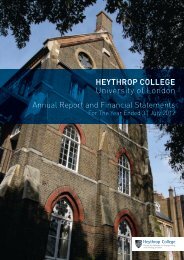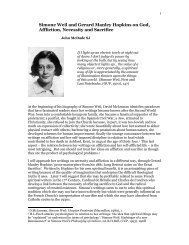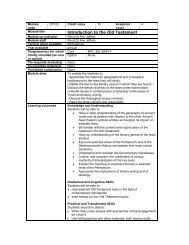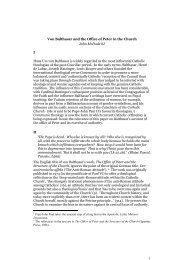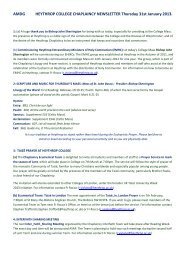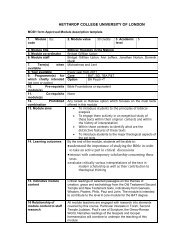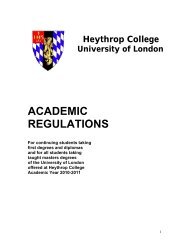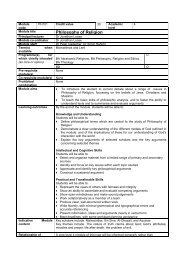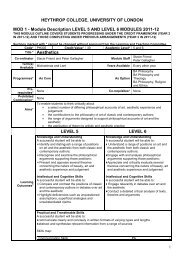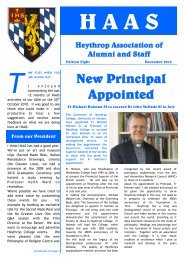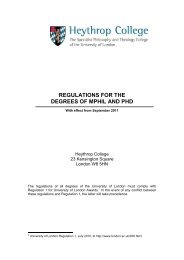Wallace_Stevens.pdf - Heythrop College
Wallace_Stevens.pdf - Heythrop College
Wallace_Stevens.pdf - Heythrop College
You also want an ePaper? Increase the reach of your titles
YUMPU automatically turns print PDFs into web optimized ePapers that Google loves.
20<br />
God. Are all our meanings ultimately, despairingly for Nietzsche, grounded in the reality of God’s<br />
making an order of being which is the condition of there being a creaturely, freely constituted<br />
world that the mind, emerging from properties within that world, comes to explore and express<br />
When I listen to Johann Sebastian Bach’s instrumental music, I hear it as a musical transcription<br />
of an infinitely complex world coming from the silence of a simple God: it is, in sounds, what the<br />
world looks like when it comes from God, ordered, subject to dissonances because it is physical<br />
and imperfect, but these dissonances are ultimately resolved by harmony, the musical equivalent<br />
of grace.<br />
In this realist perspective, the world has an objective status which is interpreted artistically: if art<br />
enchants, it is because the world is suffused with the beauty of the divine action. Enchantment<br />
then is not the consequence of aesthetically pleasing imaginings, but what happens when we come<br />
into contact with a world sustained by ‘actuality’, ipsum esse. There is an order of reality: namely,<br />
the world as it comes from God, and this is an extension of the expressiveness proper to the divine<br />
being itself, and it is suffused with the qualities of goodness, truth and beauty.<br />
For Aquinas, the condition of there being a world at all is that there is are movements of selfimaging<br />
and unitive love in God that come to be causal ‘outside’ God. 58 This enables Aquinas to<br />
secure the status of creation as the object of divine goodness springing directly from the dynamic<br />
life of God. His argument is that if there is a Word in God, an exuberant expressiveness proper to<br />
the divine nature, and if there is also Love, the impulse of charity, goodness and self-gift, then<br />
within the generativity of the real (Ipsum esse) arises the fictive making that produces the world.<br />
God’s self-imaging Word – for Aquinas and Bonaventure, the Word is the image not only of God<br />
but also of the creatures that will come from God – is the condition of the world’s existence. For<br />
Aquinas, then, the Word is the ‘supreme fiction’ within God that makes the world be; it wholly<br />
contains the divine mind, ‘below which it cannot descend,/ Beyond which it has no will to rise’<br />
(‘Of Modern Poetry’); it is ‘the finding of a satisfaction’, God’s articulation of his reality in a way<br />
that, when it is extended ad extra, makes the world be.<br />
Put crisply, the intransitive actions within God of knowledge and love are the conditions of the<br />
transitive actions outside God, namely, creation. The otherness of the creation is the created<br />
effect, the extension ad extra, of an intelligent alterity within the divine life; the existence of<br />
creaturely agents capable of free self-determination is grounded in the free circulation of being,<br />
thought and love within God. Because there is a divine Word that gives rise to things, our (lesser)<br />
words are transcriptions and signs of the things constituted by divine goodness. When we create<br />
visual, verbal and auditory art, we enact and evoke, in ways proper to our nature, the divine act of<br />
imagining that makes the world be in the first place.<br />
From this classical theistic perspective, the truth and beauty of the world are features of things as<br />
they come from God. The work of the poet or artist connects with the real as a finite ‘making’ (in<br />
words, objects and sounds) that corresponds to, evokes and in some measure participates in<br />
God’s infinite ‘making’ the world to be. The divine intellect ‘thinks’ the world and, by thinking it,<br />
makes it, and the artist analogously thinks a version of the world and makes it in his or her chosen<br />
medium. The Catholic Cathedral in Palermo in Sicily was built by Arab workmen, and they were<br />
permitted to place an Arabic inscription – I think from the Qur’an – above one of the doors that<br />
reads, ‘When God made the world, he did not make everything’: there is, in other words, still the<br />
scope for human ‘making’ as a participation in the creation of a ‘true, beautiful, good’ world.<br />
These are elements in an account which is as imaginative as it is (or claims to be) ontological. Its<br />
strength is that it preserves the status of the world as participating in an objectively constituted<br />
order of truth and goodness. It differs considerably from the presuppositions which guide<br />
58 ‘The going out of the persons [of the Trinity] in the unity of essence is the cause of the going out<br />
of creatures in the diversity of essence’ (Aquinas, I Sent. d.2, divisio textus). ‘The eternal<br />
processions [of the persons in God] are the cause and reason (causa et ratio) of the production of<br />
creatures’ (Aquinas, I Sent.d.14,q.1,a.1).



